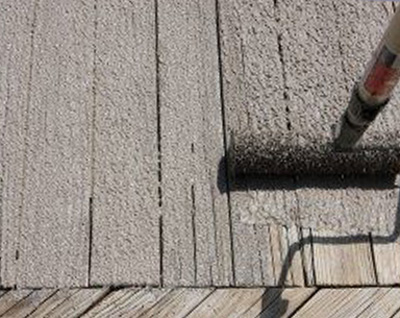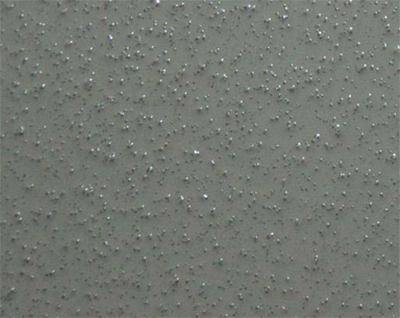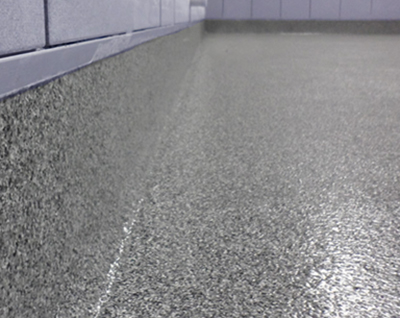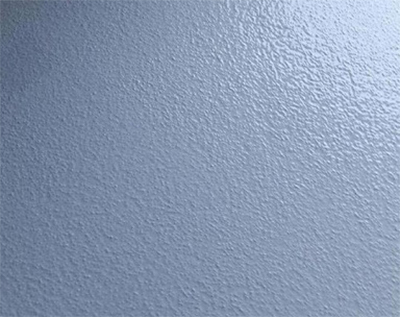Customized Stop-the-Slip Solutions
For Your Unique Conditions
Your Stop-the-Slip Solutions Graded:
Handi-Treads: A
If you’ve got wood stairs that are showing their age, Handi-Treads can actually extend the life of the wood treads. Because Handi-Treads are made from a sturdy, single piece of aluminum, they act like a splint when attached with wood screws. Properly installed, Handi-Treads can help to stabilize the wood while also serving as a superior form of slip and fall prevention in nearly any weather condition.
The raised traction buttons of the aluminum tread are uniquely self-cleaning. The pressure from a foot stepping on the rigid raised buttons disperses the layer of water, frost, or snow, creating solid contact between the tread and shoe.
Installation of Handi-Treads couldn’t be easier. In contrast to the multi-task effort required to install traction tape or grit paint, there’s no need for time-consuming surface preparation prior to installation. Once installed, no maintenance is required for Handi-Treads, which are guaranteed to last a lifetime.
If you live in an area where it snows, you’ll find that you can use a snow shovel on your Handi-Treads without fear of damage to the treads. This is not the case with most other solutions.
Because Handi-Treads are a lifetime solution with once-and-done installation and maintenance, their initial cost is higher. When calculated over a three to five year performance period however, the investment in Handi-Treads is often the most-cost effective solution.

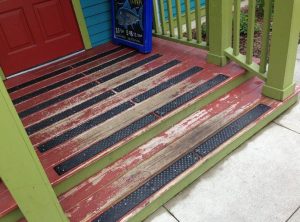
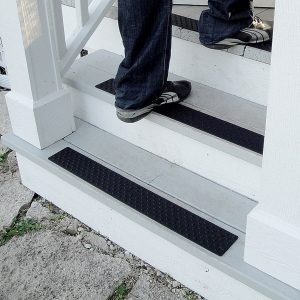
Total Score: A
Effectiveness: A
Installation & Maintenance: A
Durability: A
Initial Price: C
Long-Term Value: A
Handi-Treads Nosings: A
If you’ve got wood stairs that are showing their age, Handi-Treads can actually extend the life of the wood treads. Because Handi-Treads are made from a sturdy, single piece of aluminum, they act like a splint when attached with wood screws. Properly installed, Handi-Treads can help to stabilize the wood while also serving as a superior form of slip and fall prevention in nearly any weather condition.
The raised traction buttons of the aluminum tread are uniquely self-cleaning. The pressure from a foot stepping on the rigid raised buttons disperses the layer of water, frost, or snow, creating solid contact between the tread and shoe.
Installation of Handi-Treads nosings couldn’t be easier. In contrast to the multi-task effort required to install traction tape or grit paint, there’s no need for time-consuming surface preparation prior to installation. Once installed, no maintenance is required for Handi-Treads, which are guaranteed to last a lifetime.
If you live in an area where it snows, you’ll find that you can use a snow shovel on your Handi-Treads without fear of damage to the treads. This is not the case with most other solutions.
Because Handi-Treads are a lifetime solution with once-and-done installation and maintenance, their initial cost is higher. When calculated over a three to five year performance period however, the investment in Handi-Treads is often the most-cost effective solution.
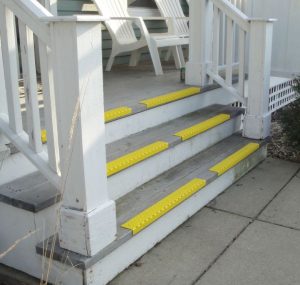
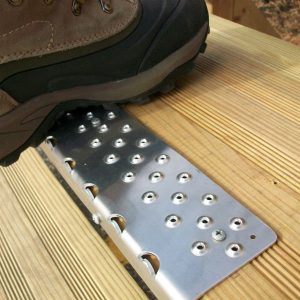
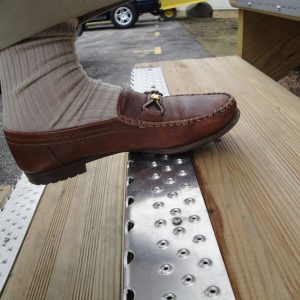
Total Score: A
Effectiveness: A
Installation & Maintenance: A
Durability: A
Initial Price: C
Long-Term Value: A
Rubber or Door Mat Style Treads: C
Door mat style and rubber treads are two of the most common solutions to slippery outdoor wood steps. The rubber treads often have a texture or design protruding from the rubber that offer very good grip when wetness or light frost exists. Door mat style treads are good at improving grip when wet, but their effectiveness varies based on the material used and the aggressiveness of their texture. They are also less effective with leather soled shoes.
Both rubber and door mat style treads are effective in winter weather only if they are kept free of snow. Care must be taken when using a snow shovel with rubber treads, as even a plastic blade can cut the rubber. Snow can be removed from door mat style treads with a shovel fairly easily as long as care is taken not to lodge the shovel under the edge of the tread.
Installation and maintenance of rubber and door mat style treads is a mixed bag on outdoor wooden stairs. Some of the products suggest just placing the “anti-slip” treads on the wooden stairs without any screws or glue permanently attaching the treads to the wood steps. We think this is a horrible idea as the treads might actually become a hazard themselves if you were to catch a toe, or were the treads were to move under the heavy pressure of a person starting to slip.
We can only recommend rubber or door mat style treads if you permanently affix them to your stairs with screws or adhesive. Assuming you choose either of these methods you’ll find that the installation can have its share of difficulties as detailed here. Both of these types of treads are maintenance free, but they do wear down with use. Depending upon thickness and quality of the material you can expect rubber or door mat style treads to last 2 to 5 years.

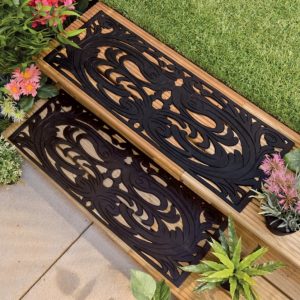
Total Score: C
Effectiveness: C
Installation & Maintenance: C
Durability: C
Initial Price: B
Long-Term Value: C
Grit Paint: C+
Grit paint can improve the safety of outdoor wood stairs if (1) it’s a high-quality enamel or epoxy paint, (2) it’s applied meticulously and (3) it’s maintained properly. Like grit tape, non-slip paints include an aggregate that creates traction. The best anti-slip paints contain aluminum oxide or carborundum that, while encapsulated in the paint, creates a rough, slip resistant surface. We rate the effectiveness of grip paint very high for wet weather, frost, and a dusting of snow.
As previously suggested, the quality of the paint and proper application is critical to the longevity of grip paint. If the wood is in good shape, it is cleaned and prepared properly, and the paint is applied according to instructions, you can anticipate that anti-slip paint will last 2 to 5 years under normal consumer traffic.
Anti-slip paints on exterior wood steps are, by and large, maintenance free. However, if you live where it snows you need to be very careful not to aggressively shovel the stairs painted with grit paint. While the epoxy or enamel coating is durable under normal foot traffic, it’s no match for an aluminum or even plastic snow shovel. Once you start to scrape way the thin paint layer covering the aggregate, the system will quickly degrade.
The cost of a high-quality grit paint can run between $50 and $100 a gallon. In addition, you’ve got the consumable cost of paint brushes or rollers, trays, sandpaper, masking tape, and drop cloths. When all costs are factored, and depending upon the number of stairs, grit paint can be one of the most expensive solutions.
